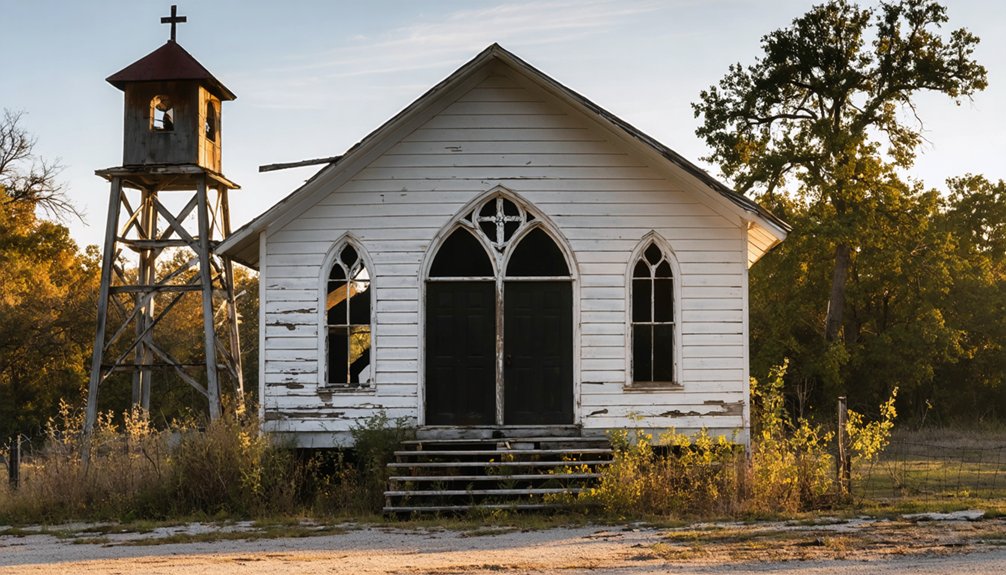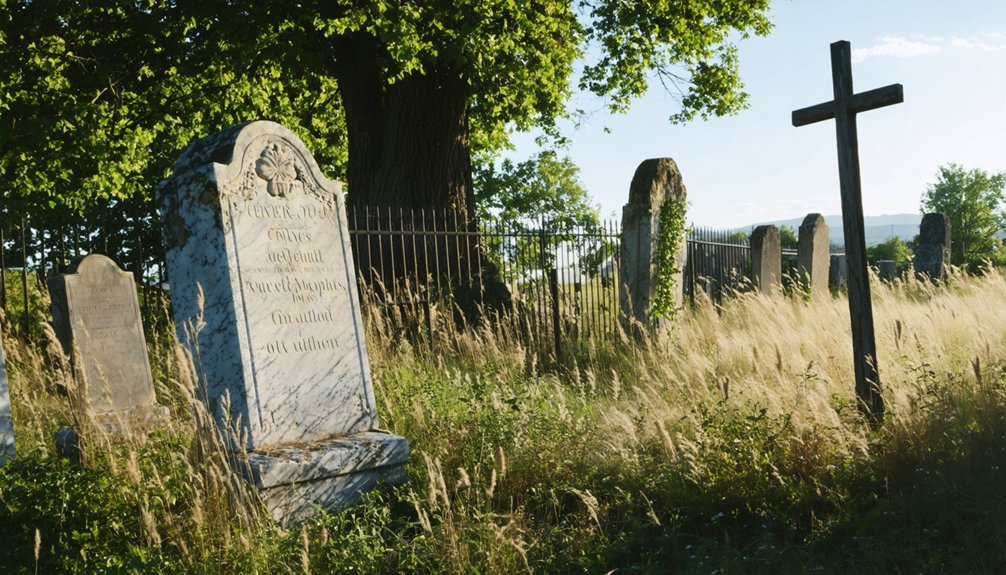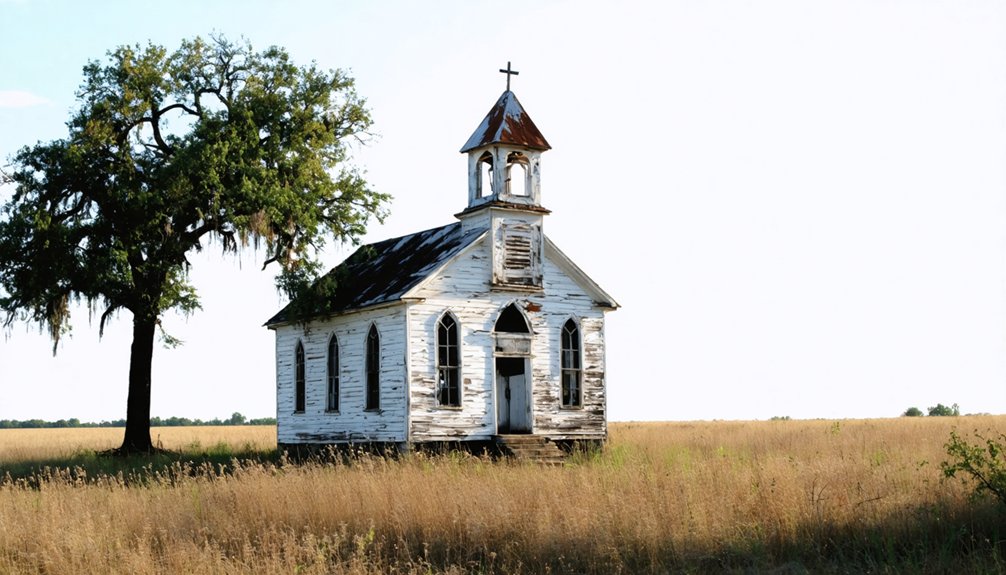You’ll find Minter’s Chapel ghost town in Tarrant County, Texas, where Green Washington Minter established a Methodist settlement in the 1850s. The community grew around a log church and cemetery, with circuit riders serving the congregation. Today, only the historic Minter’s Chapel Cemetery remains, preserving over 450 graves dating back to 1857. While DFW Airport’s expansion claimed most of the original settlement in 1967, the cemetery’s weathered headstones tell remarkable stories of Texas’s pioneer heritage.
Key Takeaways
- Minter’s Chapel was established in the 1850s by Green Washington Minter as a Methodist church community in Texas.
- The settlement declined due to lack of railroad access and reduced agricultural labor needs as families moved to larger towns.
- Only the cemetery and church remnants remain today, with the original settlement completely vanished from its former location.
- The historic cemetery survived DFW Airport’s 1967 expansion, preserving 1.5 acres of the original 4.1-acre church grounds.
- The cemetery contains over 450 burials dating back to 1857, serving as the last physical testament to this ghost town.
Early Settlers and Town Namesake
As settlers moved into northeastern Tarrant County in the 1850s, Green Washington Minter emerged as a pivotal figure in establishing what would become Minter’s Chapel. You’ll find his lasting influence through the Methodist church he helped organize, which became the heart of the frontier community.
Minter’s settler contributions extended beyond religious leadership. Along with his wife Jane Large Minter, he helped forge the community’s identity through the establishment of the original congregation. One of the earliest signs of the settlement’s growth was the 1857 burial of A.M. Newton in the cemetery grounds.
His son-in-law, James Cate, strengthened these foundations by donating 4.1 acres for the church and cemetery grounds. The settlement, primarily populated by families from Missouri and Illinois, took its name from Minter’s chapel, reflecting the common practice of honoring prominent local figures who shaped these early Texas communities. The congregation’s first worship space was a simple log meetinghouse that served the community until 1882.
Rise of Methodist Faith in Frontier Texas
In frontier Texas, you’d find Methodist circuit riders traversing vast territories to establish new congregations and minister to scattered settlers across the prairies.
These dedicated traveling preachers laid the groundwork for permanent Methodist churches, often starting with services in homes before communities could construct proper buildings. One such humble beginning occurred when early congregations met in dirt floor buildings, demonstrating their commitment despite basic conditions.
Despite challenges like hostile Indians, warfare, and epidemics, Methodist membership grew steadily to reach 6,693 members by 1845.
Early Circuit Rider Impact
Circuit riders played a transformative role in spreading Methodism across frontier Texas, despite facing tremendous odds and minimal resources. These brave frontier ministers traversed dangerous territories with little more than their faith and saddlebags, bringing spiritual comfort to isolated settlers.
- You’d find these dedicated preachers conducting services anywhere they could – from open fields to cramped cabins, adapting to the rugged demands of frontier ministry.
- They’d risk their lives crossing treacherous terrain and facing wild animals to reach remote communities.
- You’d witness them serving multiple roles beyond preaching – as teachers, medical assistants, and fort chaplains.
- They’d unite scattered populations through revival meetings and community gatherings, creating bonds of fellowship in the wilderness.
Many of these dedicated ministers were compensated with farm crops and goods instead of money for their services. Their grueling routes typically took five to six weeks to complete.
Circuit rider stories reveal how just six Methodist preachers in 1838 built the foundation for Texas’s largest pre-Civil War denomination.
Church Building Pioneer Spirit
Four pioneer families, led by Reverend Green Washington Minter and his son-in-law James Cate, established Minters Chapel in 1854, marking a pivotal moment in Texas Methodist frontier expansion.
You’ll find their pioneer resilience reflected in the congregation’s growth from a humble log cabin to an 1882 frame church building on Cate’s donated 4.1-acre parcel.
The chapel became more than just a worship space – it served as a hub for community gatherings, education, and spiritual life despite the harsh frontier conditions.
The Tarrant County location helped establish the church as a significant piece of North Texas cultural heritage.
When the Dallas-Fort Worth Regional Airport threatened its existence in 1967, the congregation’s determination preserved their heritage by relocating the building to Heritage Avenue in Grapevine.
Today, both the church and cemetery stand as monuments to these Methodist settlers‘ unwavering commitment to faith and community.
Cemetery Tales and Historical Records
While many Texas ghost towns fade into obscurity, Minter’s Chapel Cemetery stands as a remarkably well-documented historical site with records spanning over 160 years.
You’ll find burial customs preserved through the thorough 27-page record maintained by the Cemetery Association, detailing the final resting places of over 450 souls who shaped this corner of Tarrant County. Modern documentation shows 94% of memorials photographed, ensuring these histories remain accessible for future generations. The dedicated volunteers have achieved an impressive 82% photographed memorials rate for the site.
- The oldest marked grave belongs to A.M. Newton from 1857, telling tales of the earliest settlers.
- Clusters of small graves reveal the harsh realities of 19th-century child mortality.
- The cemetery survived DFW Airport’s expansion in 1967, preserving 1.5 acres of sacred ground.
- Methodist settlers’ gravestones chronicle the area’s religious heritage, with markers spanning generations.
The site continues welcoming new burials today, bridging past and present while keeping cemetery legends alive.
From Thriving Settlement to Ghost Town
Beyond the well-preserved cemetery lies a story of gradual decline that transformed a once-vibrant settlement into today’s ghost town.
You’ll find that Minter’s Chapel’s community evolution followed a different path than many Texas ghost towns – instead of a dramatic boom-bust cycle, it experienced a slow fade. Without railroad access or significant industry to sustain growth, the settlement couldn’t compete with developing nearby towns.
As agricultural challenges mounted in the early 20th century, you’d have witnessed the impact of mechanization reducing labor needs while rural depopulation trends took hold. Families gradually moved away seeking better opportunities in larger towns. Unlike Shafter’s decline from its silver mining operations, the town never experienced a dramatic economic crash from a single industry.
Today, you’ll discover little remaining of the original settlement except the cemetery and church remnants, silent testimonies to a community that once centered around farming and faith.
Architectural Heritage and Church History

Since its founding in 1854, Minters Chapel Methodist Church has anchored the spiritual and social fabric of this rural Texas settlement.
From its humble beginnings as a log cabin meetinghouse to the 1882 frame building, the church’s architectural significance lies in its utilitarian design that embraced Methodist traditions of simplicity.
The structure’s community resilience became evident when urban development forced its relocation in 1967, though the historic cemetery remained at its original site.
- You’ll find pioneer craftsmanship in the original log structure, built by determined settlers who carved out a place of worship from the frontier.
- You’re walking the same ground where James Cate’s 4.1-acre donation created a crucial community center.
- You can trace the congregation’s strength through their shift from log cabin to frame building.
- You’re witnessing a representation of preservation as the church building survived relocation while maintaining its heritage.
Legacy in Stone: Notable Grave Markers
The historic Minters Chapel Cemetery holds a wealth of stories etched in stone, starting with A.M. Newton’s 1857 marker, the earliest documented grave.
You’ll find over 450 memorials spread across 1.5 acres, featuring diverse grave symbolism and marker materials typical of 19th-century Texas cemeteries.
Among the most notable monuments is that of Minister Green W. Minter (1803-1887), the community’s founder, whose distinctive marker stands as a representation of his influence.
The cemetery’s stones reveal poignant details of early settler life, with numerous small graves reflecting the era’s high child mortality rate. Many headstones showcase Methodist iconography and epitaphs, though weathering has taken its toll.
Despite challenges from airport proximity and environmental exposure, these markers continue to serve as vital genealogical records for eastern Tarrant County’s founding families.
Preserving Tarrant County’s Oldest Cemetery

Located west of Dallas-Fort Worth International Airport, Minter’s Chapel Cemetery stands as Tarrant County’s oldest burial ground, encompassing 1.5 carefully preserved acres.
Despite urban development and airport expansion in 1967, this historic cemetery has maintained its original integrity, serving as a symbol of early Texas settlement patterns and Methodist heritage.
- You’ll find weathered headstones dating back to 1857, including the earliest marked grave of A.M. Newton.
- You’re walking among the final resting places of pioneer families who shaped Tarrant County’s development.
- You’re witnessing the poignant reminders of pioneer life through numerous small graves of children.
- You’re experiencing a site where cemetery preservation efforts continue through local organizations dedicated to protecting this irreplaceable piece of Texas history.
The cemetery’s historical significance endures through active documentation and community engagement, ensuring its legacy for future generations.
Frequently Asked Questions
What Natural Disasters or Events Contributed to the Town’s Abandonment?
You’ll find no direct evidence of catastrophic natural disasters, though regional flood damage may have contributed. The town’s abandonment was more likely due to typical rural economic decline.
Are There Any Documented Supernatural Occurrences at Minter’s Chapel Cemetery?
You’ll find documented ghost sightings including followers on Demons Road, mysterious hands emerging from graves, unexplained church bells, and spirits following visitors home from Minter’s Chapel cemetery according to local legends.
How Many Original Minter Family Members Are Buried in the Cemetery?
You’ll find at least one confirmed burial – Green W. Minter (1803-1887) – but the exact count of original Minter family members isn’t definitively documented, though cemetery records suggest several related graves exist.
What Was the Peak Population of Minter’s Chapel During Its Existence?
You’ll find that Minter’s Chapel reached its peak population of 100 residents, maintaining this level from 1914 through the mid-1950s, reflecting modest community dynamics typical of rural religious settlements in the region.
Were There Any Notable Businesses or Industries in Minter’s Chapel?
You won’t find any notable businesses in the records – no ghostly legends of bustling local businesses exist. The community centered around its Methodist church and small-scale farming activities.
References
- https://texashistoricalmarkers.weebly.com/minters-chapel-cemetery.html
- https://brandonsnotepad.wordpress.com/2016/03/08/where-is-muriel-texas/
- https://en.wikipedia.org/wiki/List_of_ghost_towns_in_Texas
- https://www.texasescapes.com/CentralTexasTownsNorth/Minter-Texas.htm
- https://www.hmdb.org/m.asp?m=201917
- https://texashistory.unt.edu/ark:/67531/metapth28282/
- https://www.ghosttowns.com/states/tx/minterschaple.html
- https://atlas.thc.texas.gov/Details/5439003397
- https://www.grapevinetexas.gov/777/Grapevine-History-1843—1900
- https://www.firstmethodistgrapevine.org/history



